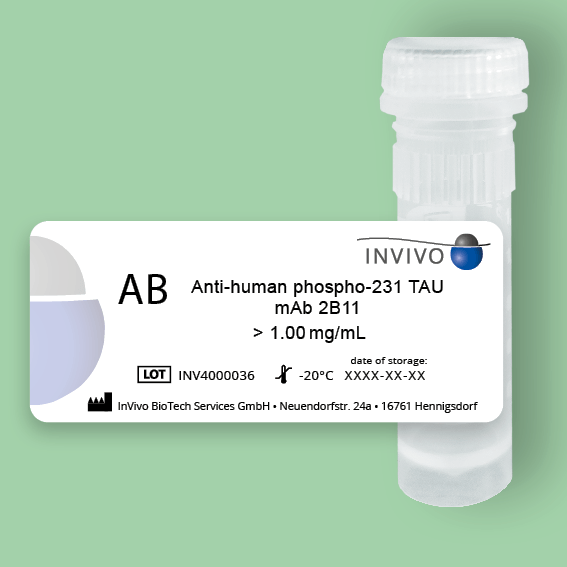Anti-human phospho-231 TAU mAb 2B11
Tau protein is a microtubule-associated protein mainly found in neurons, that regulates microtubule stability and axonal transport. It is classified as an intrinsically disordered protein, allowing it to adopt multiple conformations and interact with diverse cellular partners.
The antibody is produced exclusively from hybridoma and purified through one-step purification with Protein-A affinity chromatography.
In stock
Delivery time: 2-5 days
From: 326,00 € Excl. VAT and delivery costs
Please contact us for larger quantities.
Tau protein is a microtubule-associated protein mainly found in neurons, that regulates microtubule stability and axonal transport. It is classified as an intrinsically disordered protein, allowing it to adopt multiple conformations and interact with diverse cellular partners. Tau proteins contain numerous potential phosphorylation sites that regulate it´s conformational changes and interactions. In pathological states, especially neurodegenerative disorders, hyperphosphorylation arises, leading to aggregation into neurofibrillary tangles - a hallmark of tauopathies like Alzheimer's disease.
The clone 2B11 is a Monoclonal Mouse antibody against Human Phospho-Tau (Thr231), Microtubule-associated protein tau (MAPT) (Uniprot: B3KTM0).
The antibody is produced exclusively from hybridoma and purified through one-step purification with Protein-A affinity chromatography.
| Product-ID: | INV4000036 |
|---|---|
| Clone: | 2B11 |
| Immunogen: | Animals were immunized with Synthetic peptide KKVAVVRT(Pi)PPKSPSS |
| Host: | Mouse |
| Clonality: | Monoclonal |
| Isotype: | IgG1k |
| Formulation: | Clear Liquid, PBS, pH 7.4 |
| Concentration: | > 1.0 mg/ml |
| Purity: | > 95% by SDS-PAGE |
| Sizes available: | 0.1 mg and 1.0 mg |
| Storage: | at - 20 °C (repeated thawing and freezing should be avoided) |
| Tested application(s): | ELISA, Western Blot, Immunhistochemistry |
The product is for research use only and not for use in diagnostic or therapeutic procedures.
Additional information
| Literature | [1] – Mark S. Forman, Virginia M.-Y. Lee, John Q. Trojanowski. New insights into genetic and molecular mechanisms of brain degeneration in tauopathies, Journal of Chemical Neuroanatomy, Volume 20, Issues 3–4, 2000, Pages 225-244, ISSN 0891-0618, https://doi.org/10.1016/S0891-0618(00)00100-9. |
|---|---|
| Document | |
| Protocol | |
| Notice | The product is for research use only and not for use in diagnostic or therapeutic procedures. |
You must be logged in to post a review.

Reviews
There are no reviews yet.